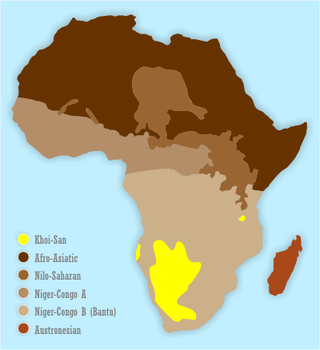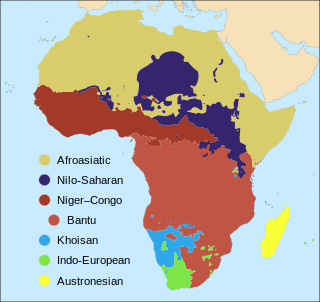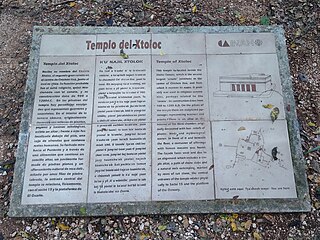
The Khoisan languages are a number of African languages once classified together, originally by Joseph Greenberg. Khoisan is defined as those languages that have click consonants and do not belong to other African language families. For much of the 20th century, they were thought to be genealogically related to each other, but this is no longer accepted. They are now held to comprise three distinct language families and two language isolates.

The number of languages natively spoken in Africa is variously estimated at between 1,250 and 2,100, and by some counts at over 3,000. Nigeria alone has over 500 languages, one of the greatest concentrations of linguistic diversity in the world. The languages of Africa belong to many distinct language families, among which the largest are:

An endangered language or moribund language is a language that is at risk of disappearing as its speakers die out or shift to speaking other languages. Language loss occurs when the language has no more native speakers and becomes a "dead language". If no one can speak the language at all, it becomes an "extinct language". A dead language may still be studied through recordings or writings, but it is still dead or extinct unless there are fluent speakers. Although languages have always become extinct throughout human history, they are currently dying at an accelerated rate because of globalization, mass migration, cultural replacement, imperialism, neocolonialism and linguicide.

The Indigenous languages of the Americas are the languages that were used by the Indigenous peoples of the Americas before the arrival of non-Indigenous peoples. Over a thousand of these languages are still used today, while many more are now extinct. The Indigenous languages of the Americas are not all related to each other, instead they are classified into a hundred or so language families, as well as a number of extinct languages that are unclassified due to the lack of information on them.
Linguistic imperialism or language imperialism is occasionally defined as "the transfer of a dominant language to other people". This language "transfer" comes about because of imperialism. The transfer is considered to be a sign of power; traditionally military power but also, in the modern world, economic power. Aspects of the dominant culture are usually transferred along with the language. In spatial terms, indigenous languages are employed in the function of official (state) languages in Eurasia, while only non-indigenous imperial (European) languages in the "Rest of the World". In the modern world, linguistic imperialism may also be considered in the context of international development, affecting the standard by which organizations like the International Monetary Fund and the World Bank evaluate the trustworthiness and value of structural adjustment loans by virtue of views that are commonly foregrounded in English-language discourse and not neutral.
Language revitalization, also referred to as language revival or reversing language shift, is an attempt to halt or reverse the decline of a language or to revive an extinct one. Those involved can include linguists, cultural or community groups, or governments. Some argue for a distinction between language revival and language revitalization. There has only been one successful instance of a complete language revival, the Hebrew language, creating a new generation of native speakers without any pre-existing native speakers as a model.
Ongota is a moribund language of southwest Ethiopia. UNESCO reported in 2012 that out of a total ethnic population of 115, only 12 elderly native speakers remained, the rest of their small village on the west bank of the Weito River having adopted the Tsamai language instead. The default word order is subject–object–verb. The classification of the language is obscure.

In linguistics, language death occurs when a language loses its last native speaker. By extension, language extinction is when the language is no longer known, including by second-language speakers, when it becomes known as an extinct language. A related term is linguicide, the death of a language from natural or political causes, and, rarely, glottophagy, the absorption or replacement of a minor language by a major language.

In Uganda the most spoken language in the capital city is Luganda, followed by English, as all schools in Uganda use it in their studies due to the introduction of English during the colonial period. English is also the language of business and judicial matters. Most spoken after Luganda and English is Swahili. This language is more common in neighbouring Kenya and Tanzania. Swahili is taught in schools as an optional additional language and it is mostly spoken by the Ugandan army. In 2005, there were talks to include Swahili as the second official language as it was seen as neutral, however this is still not ratified by the government. Swahili is used among some communities bordering South Sudan and Kenya.

The languages of Ethiopia include the official languages of Ethiopia, its national and regional languages, and a large number of minority languages, as well as foreign languages.

The Constitution of Mexico does not declare an official language; however, Spanish is the de facto national language spoken by over 99% of the population making it the largest Spanish speaking country in the world. The government also recognizes 63 indigenous languages spoken in their communities out of respect, including Nahuatl, Mayan, Mixtec, etc.
An indigenous language, or autochthonous language, is a language that is native to a region and spoken by its indigenous peoples. Indigenous languages are not necessarily national languages but they can be; for example, Aymara is both an indigenous language and an official language of Bolivia. Also, national languages are not necessarily indigenous to the country.

The Republic of Vanuatu has the world's highest linguistic density per capita. Despite being a country with a population of less than 300,000, Vanuatu is home to 138 indigenous Oceanic languages.
The Ware were a Bantu ethnic/ linguistic group in Tanzania. They are believed to have become extinct. Around 1900, they were still living on an island in the Eastern part of Lake Victoria off the coast of Mara Region. According to Maho & Sands (2002), their language has died out as mentioned by Sommer. It is not known whether there are still people calling themselves "Ware" today in that area, nor which language they would be speaking.
El Molo is an extinct language belonging to the Cushitic branch of the Afro-Asiatic language family. It was spoken by the El Molo people on the southeastern shore of Lake Turkana, in northern Kenya. Alternate names to El Molo are Dehes, Elmolo, Fura-Pawa, and Ldes. It was thought to be extinct in the middle part of the 20th century, but a few speakers were found in the later 20th century. However, it may now be truly extinct, as the eight speakers found in a survey published in 1994 were over 50. Most of the El Molo population have shifted to the neighboring Samburu language. El Molo also has no known dialects but it is similar to Daasanach.

Burkina Faso is a multilingual country. An estimated 70 languages are spoken there, of which about 66 are indigenous. Mooré is spoken by about 52.5% of the population, mainly in the central region around the capital, Ouagadougou.

The languages of the Caribbean reflect the region's diverse history and culture. There are six official languages spoken in the Caribbean:

The Bantu peoples are an ethnolinguistic grouping of approximately 400 distinct native African ethnic groups who speak Bantu languages. The languages are native to 24 countries spread over a vast area from Central Africa to Southeast Africa and into Southern Africa. There are several hundred Bantu languages. Depending on the definition of "language" or "dialect", it is estimated that there are between 440 and 680 distinct languages. The total number of speakers is in the hundreds of millions, ranging at roughly 350 million in the mid-2010s. About 60 million speakers (2015), divided into some 200 ethnic or tribal groups, are found in the Democratic Republic of the Congo alone.

The boundaries of this corridor can be defined within the Maasai territory. The corridor stretches from the Arusha Region, through the Kilimanjaro Region of Tanzania to the Taita-Taveta County of Kenya. To varying degrees, the people in this corridor are essentially a mixture of similar Bantu, Nilotic and Cushitic branches of the African people. The groups were dynamic, fluid and flexible. They shared a common history characterised by constant movement between the different areas for trade, battles, migration as well as social reasons. They were categorised arbitrarily by Europeans into the following culturally, linguistically and/or genetically related groups:













